Important monuments
Říčany Castle
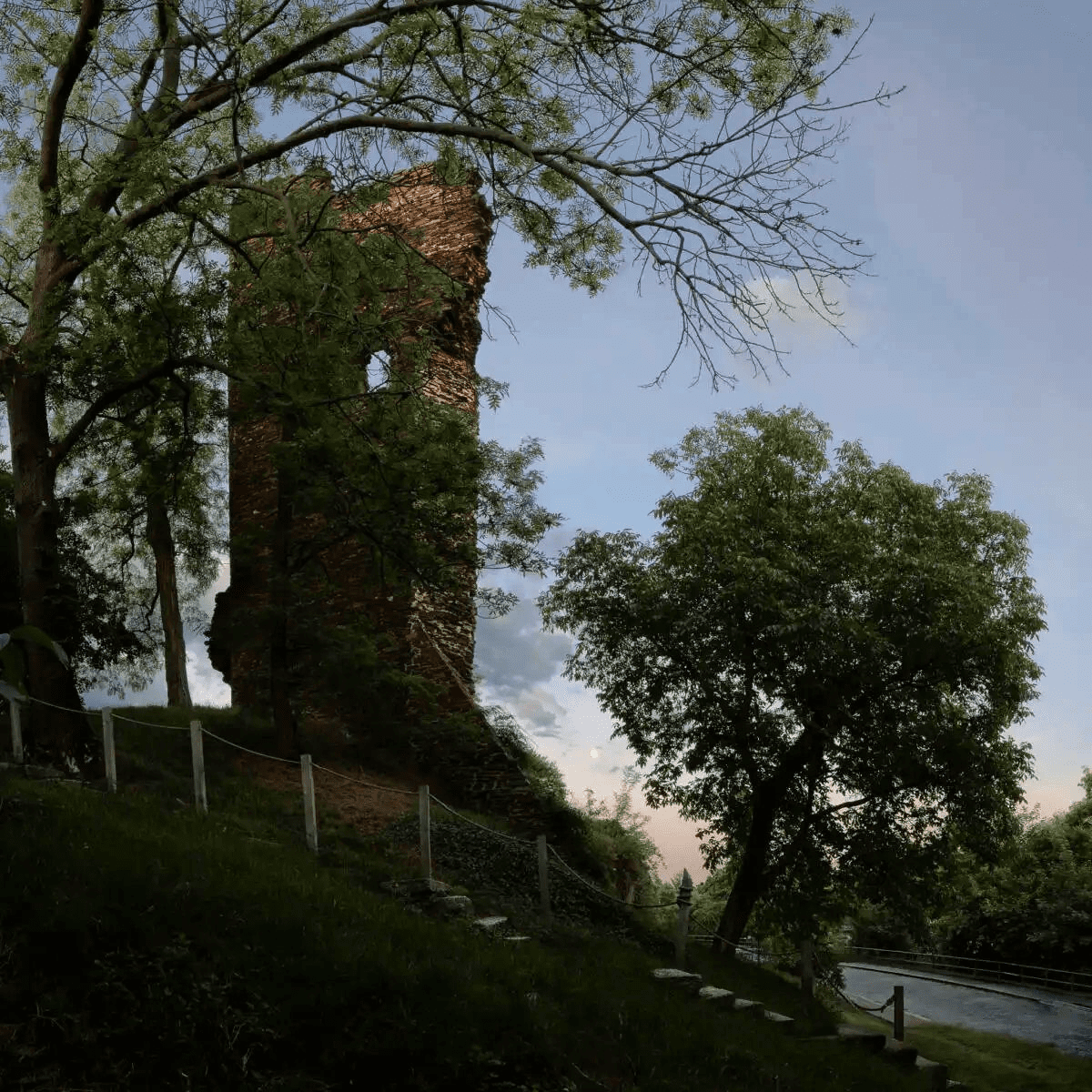
An important landmark of the town is still the ruins of a once magnificent and splendid castle from the second half of the 13th century. century, the time of the last Premyslids. More than a century of its peak glory in 14. century, ended by the Hussites, who sacked it in 1420 during their campaign against the opponents of their religion. The castle, built according to the model of the royal castles of the time, slowly decayed and was gradually dismantled into building stone. Until about the middle of the 19th century. century, the slate from the castle was certainly the most used building material, which was used to construct most of the historical buildings in the town.
On the square, whose ground plan is subject to monument protection due to its rare early Gothic plot, we can find the Church of St. Peter and Paul. It was probably built in parallel with the castle around 1260-80. The vaults of the inconspicuous chapel in its interior are decorated with frescoes from the period around r. 1400. Its current neoclassical appearance dates from 1900. Near the church we can admire the Marian column from 1699. It is a miniature of the original Marian Column from Prague’s Old Town Square and is the second oldest monument of this type in the Czech Republic.
Outside the centre we find a strange building that resembles a castle: The Olive House was founded in 1890 by the Olive family as a nursery for neglected and abandoned children. Today it serves as a children’s hospital for respiratory diseases for children from all over the country.
In modern times the town began to develop dramatically after the construction of the railway Prague – Vienna in 1869. At that time, luxury villas, recreational and sporting facilities, inns, dance halls and relaxation pavilions began to be built here.
Říčany has become a popular tourist location. The ambition of Říčany was to become a kind of “sun spa” with healthy air, beautiful nature and various possibilities of enjoyment in the immediate surroundings of the then already highly industrialised and polluted Prague.
At the end of the Thirty Years’ War, perhaps only two or three inhabited farmsteads remained in Říčany. All the other inhabitants died or had to flee. It was a disaster unprecedented in the history of the city.
Church of St. Peter and Paul
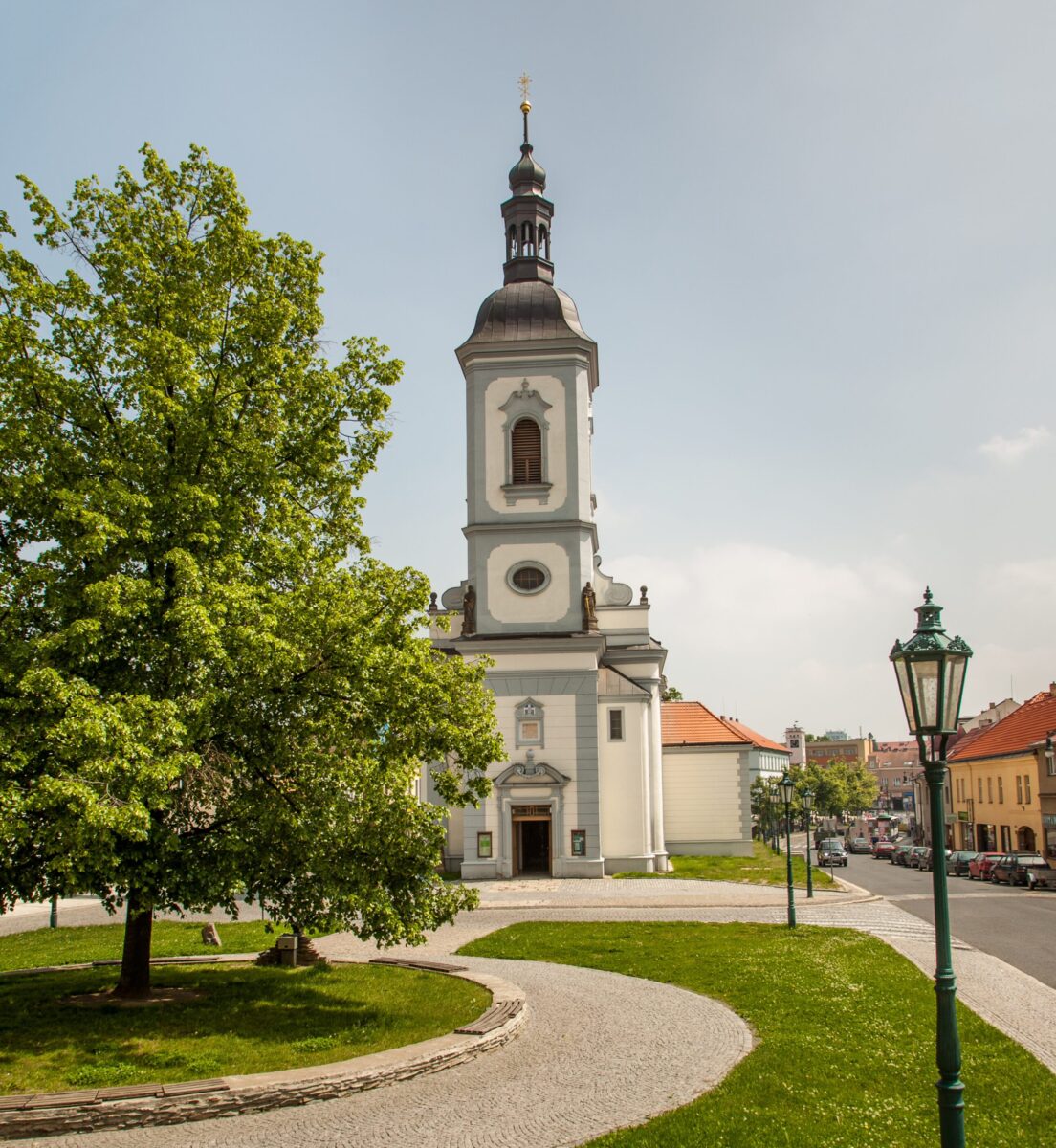
The dominant feature of the square is the originally Gothic church of St. Peter and Paul, probably from 1270. A part of the southern wall with a pointed window, the ground floor of the former tower with a cross vault and the remains of frescoes from the period around the year 1917 have been preserved from the Gothic period. 1400. In the Renaissance the church was enlarged and raised (ridge vaults in the presbytery and above both side oratories). In 1628-29 two new bells were purchased, St. Peter and slightly smaller St. Paul, which have been preserved to this day.
However, the church was almost destroyed in the following difficult times of the Thirty Years’ War. That is why the later owner of the estate, Maria Theresa of Savoy, had it rebuilt in 1719 in the High Baroque style. Building modifications were also carried out in the 19th century. Among the interior furnishings, it is worth mentioning the late Baroque altar, the pulpit from 1725, the relief of Adam and Eve from the end of the 18th century. century and three ancient tombstones. The current appearance of the church dates back to 1900.
Behind the church stands a baroque sandstone statue of the Catholic saint John of Nepomuk from the year 1917. 1759 and the modern statue of St. Wenceslas from r. 1937 carved in pseudo-Baroque style.
Marian Column
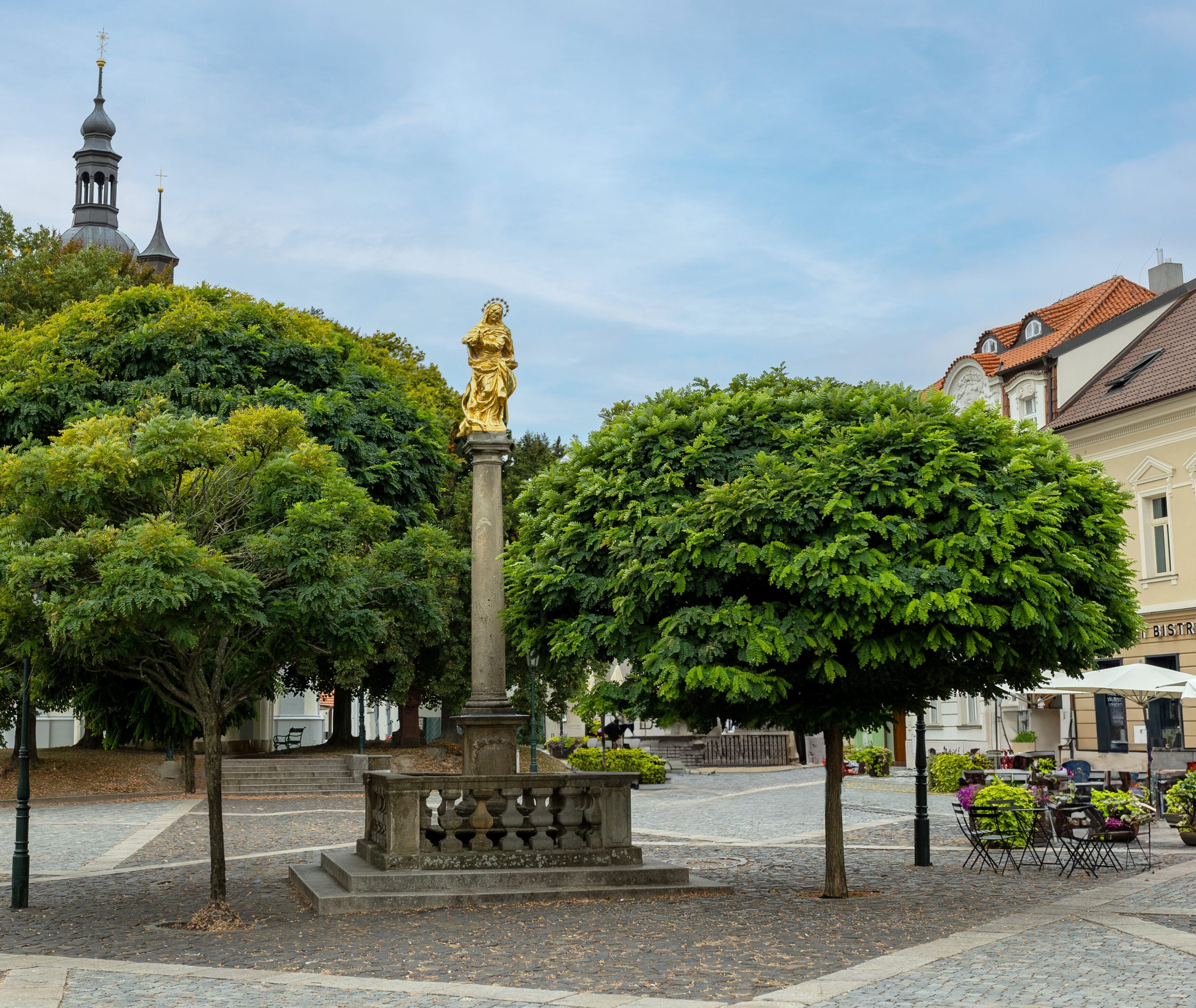
The gilded statue of Our Lady Immaculata (Immaculate) in the middle of Masaryk Square looks down from the top of a column on a stone plinth protected by a massive stone railing. The Virgin Mary has her hands clasped, a halo of ten stars around her head, and stands on a globe encircled by a serpent with an apple in its mouth (a symbol of victory over original sin). The statue from r. 1699 is a simplified version of the Marian column by the sculptor Jiří Bendel from 1652, which stood in Prague’s Old Town Square until its violent overthrow in 1918. It is not known who is the author of the Říčany column, who commissioned it and why. Usually, however, such columns were erected in thanksgiving for averting some disaster, usually plague or war. At the time of its construction it was only the second similar column in the Czech lands.
The Marian column in Říčany is the second oldest in Bohemia.
Old Town Hall
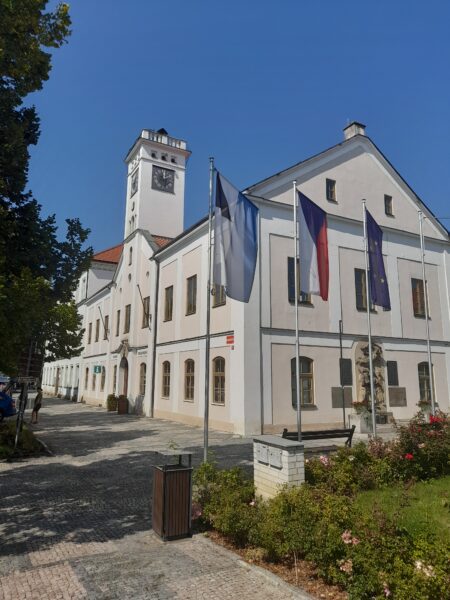
The town hall is mentioned in the first description of Říčany from 1565. Every century brought a new building. In the middle of the 19th century. century, significant reforms in state administration took place in our territory. Říčany, until then a serf town of the Uhříněves estate, se r. In 1855 it became the seat of a political district for ninety municipalities and almost 30,000 inhabitants.
There was a need for a separate town hall building, which would become a dignified seat of the district court, the tax office and the district administration. That is why in 1864 a representative two-storey building was built in the middle of the square, today called the old town hall. It is closely adjacent to the former courthouse, which stands on the site of the former town cloakroom.
On the eastern wall of the old town hall there is a monument to the national liberation and the fallen in both world wars with a sandstone relief designed by sculptor Břetislav Benda.
There is a cellar under the old town hall, which may be older than the current appearance of the building. We assume that the cellar was part of the foundations of the previous building from the 18th century. century.
Říčany was the executor of the so-called. of throat law. In the past, the town was also the seat of an executioner who performed executions on the hill on the site of today’s cemetery. These were not always executions, but often also various horrific corporal punishments. The executioner resided in the hangman’s cell below the castle, where his family farmed a large rented garden. The building of the execution chamber took over in the middle of the 20th century. century and was the last building in the town that still had a thatched roof.
They were on the town hall clock until the beginning of the 20th century. century, the hour and minute hands are interchanged. The hour was indicated by the long hand, the minute by the short one.
Toll
The oldest preserved building in Říčany is house no. p. 44 in the street 17. November. The house, called “U Čechů” after one of the first owners, was built in 1706 on the municipal land as a toll house. As is well known, a toll house used to be a place where a fee of the same name was collected for the use of roads, highways or bridges (nowadays highways or tunnels). In the Middle Ages, it was also the name of a fee collected by the local authorities at specified places for protection, for example, when passing through an estate. A duty was also levied on imported goods that were offered for sale in the city. The building of the former Říčany toll station has recently been renovated and modernised.
Říčany was located on an ancient trade route, along which caravans of salt travelled to Prague. The road to the monastery in Sázava also led through Říčany. We believe that these are the reasons why the castle was built here. He was to protect these important commercial and spiritual arteries.
Museum Říčany
It was founded in 1908 by a decision of the municipal council in Říčany on the occasion of the celebration of the 60th anniversary of the reign of Emperor Franz Joseph. It changed its location several times until, after almost forty years, it acquired a dignified premises for its activities in a villa dedicated by the patroness Růžena Klímová. Its beginnings are connected with the prominent personality of the local culture and the leading teacher Alois Mudrunka, after whom it was named for a long time.
The Říčany Museum is a widely visited and professionally recognized institution. It focuses especially on families with children and schools. Although the size of the villa in which the museum is housed does not allow for a permanent exhibition, the museum frequently organizes short-term exhibitions that speak to visitors through experiences. The museum also focuses on organizing programs for schools and educating teachers. Its scientific and ecological focus deepens the local relationship with nature and promotes responsibility towards nature. It also systematically promotes and develops craftsmanship through its own method called. creative games, which it successfully “exports” to schools and kindergartens throughout the Czech Republic.
The Říčany Museum also organizes lectures on historical topics, informative and entertaining events for the general public, brings together local patrons, patriots and memorabilia in the Club of Friends, and takes responsible care of the collection. It consists of 24,000 items and is stored in the former school building in nearby Jažlovice. Part of the collections is exhibited as part of the seasonal exhibitions of the Spek of the Season project.
The museum has a long historical tradition, but it has not been stuck in the past. Today, it is a modern, vibrant institution that keeps local people entertained. It is mainly visited by schools and families with children, but it also offers a lot to history lovers, local patriots, and veterans.
Railway Station
The development of Říčany was greatly influenced by the construction of the Prague-Benešov railway line in 1869. It was part of the railway leading to Vienna. Five years later, Říčany got its first, still ground-floor station building. This was of fundamental importance for the growth of the town and the establishment of the Říčany recreational area. The railway brought Říčany closer to Prague, because it enabled daily commuting to work and at the same time opened the local area for recreation of the inhabitants of Prague. And that the railroad had to the world! Before the First World War, sixteen trains commuted to Říčany every day, transporting 150,000 people a year. In 1937, there were already twenty regular train connections in both directions, which brought 1,900 workers and students to Prague every day. The original station building would not have been sufficient for such an onslaught of passengers, so it was rebuilt into a two-storey building in 1894.
The introduction of the railway changed the course of the history of Říčany. The small town has become a popular recreational location. Unlike other places on the Prague-Benešov line, no industrial zone was created here; on the contrary, villas, summer apartments, recreational facilities, sports facilities and hotels began to grow like mushrooms after the rain..
At the Memorial Lime Tree
The ancient village of Radošovice is first mentioned in the Land Records from 1357. The development of the Říčany recreational area in the early 20th century. century also meant a considerable territorial growth of Radošovice, which culminated in its annexation to the neighbouring Říčany. The face of the village has also changed considerably with the extensive modern residential development. The village’s past is now only reminded by the former village square in the town of radošovice, the picturesque U Památné lípy square, where time seems to have stopped. It is decorated with a cast-iron cross on a sandstone base from 1872 and an ancient chapel with a bell. On the nearby Czechoslovak Army Square, already in the middle of the First Republic buildings, there is a monument to the fallen in the First World War with a bronze plaque of the first president of the Czechoslovak Republic, T. G. Masaryk, made by František Lhoták in 1921 and with the names of the victims of the Second World War added later.
Jureček swimming pool

The Jureček swimming pool with its wooden cabanas and old-world charm still makes visitors feel like they are in the movie The Whimsical Summer. The picturesque pond by the forest gives the impression that it has always been there. In fact, she had it set up at a cost of half a million crowns in the 1920s. century in an effort to develop the resort more. In August 1934, a swimming pool with an inn was opened there, which immediately became a popular destination for excursionists. It offered not only water fun, but also music, dancing, entertainment programs, good cuisine, tennis courts and an ice rink in winter. Many well-known artists of the time – for example Ljuba Hermannová, Jiřina Štěpničková or František Smolík – also liked it. The nicest guest here, however, was Oldřich Nový, who even rented a house for his family in the neighbourhood. The swimming pool and the restaurant are named after Antonín Jureček, who took care of guests here almost from the beginning until 1958.
In 2008, the fame of this swimming pool was restored. The new operator has renovated the restaurant, which is a major attraction for locals and tourists. A new playground was built, new grass was planted, a beach volleyball court, a playground and other elements for sports activities were built. The kiosk, which offers visitors simple meals and snacks, has also been renovated.
The Jureček swimming pool is like a genuine First Republic swimming pool. And whether you want to have a beer and a sausage or go to a fancy restaurant, you will find something for yourself here!
Olive Children’s Hospital
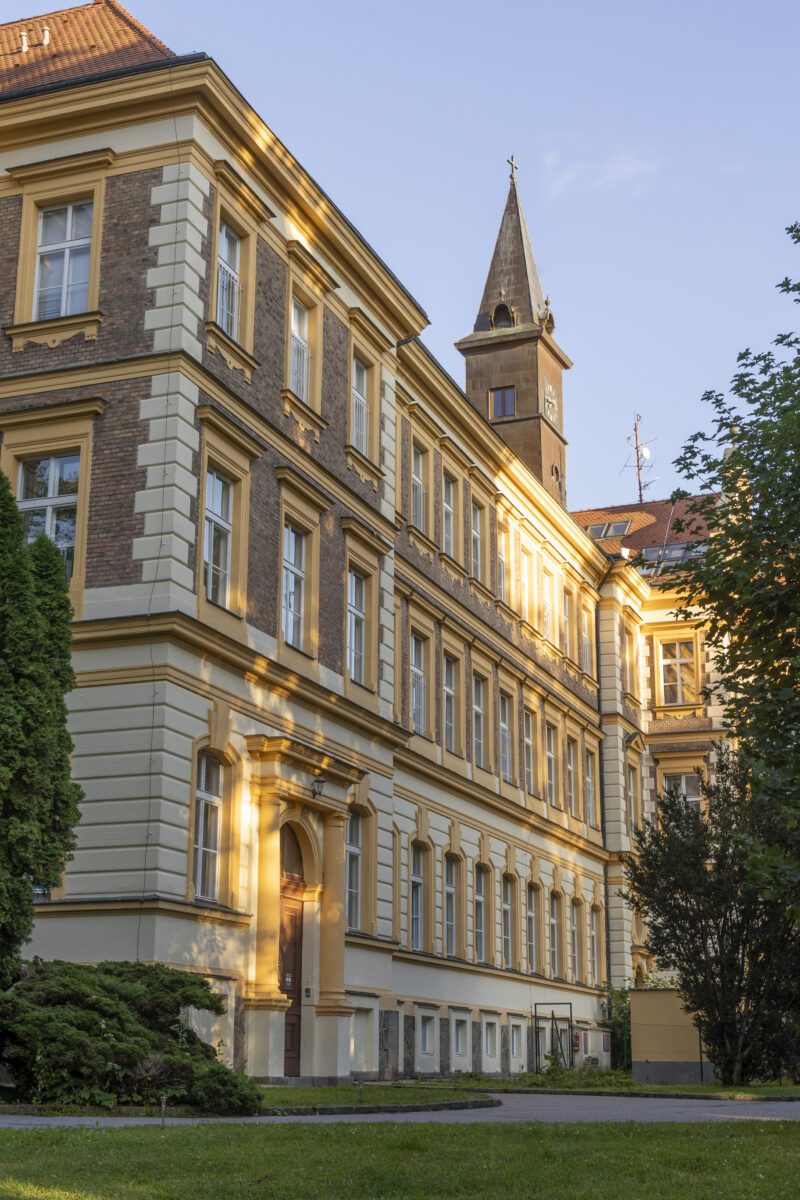
For a healthy microclimate, also recommended by the famous doctor MUDr. Josef Thomayer, was in Říčany on 18. October 1896, the “Nursery of the Oliva family” was opened by the prominent Prague burgher and patron Alois Oliva and his wife Louise. Its purpose was: ‘(…) To take care especially of morally neglected children who are in serious danger of complete moral destruction. (…) It is only in the second place that the admission of such children is permitted, for whom mere orphanhood and poverty intercede. The Institute assumes the duty of replacing their homes, of providing for their adequate physical support, of giving them the necessary schooling, of ennobling their moral character, and of preparing them for practical life with due regard to the abilities and needs of each of them.”
Seventeen persons, including teachers, a priest and a nightmaster, were responsible for the welfare and education of the eighty girls and forty boys. The institute included school classrooms, an institutional chapel, staff accommodation and a park with a garden. The running of the facility was financed primarily by the Olive Foundation, which consisted of the proceeds from the five Prague houses, then from the nursing fees paid for the children and from the proceeds of the inmates’ work on the adjacent farm building with stables, barns, granaries, fields and an orchard.
In 1926, Olivovna became the children’s sanatorium of the capital of Prague, after the Second World War it became a children’s lung sanatorium and in the early 1980s it became a children’s hospital. years, it was transformed into the Children’s Respiratory Hospital. In 1990 the Olive Foundation resumed its activities.
The Olive Room doesn’t look like a hospital, it looks like a bizarre castle from a movie! And just beyond it, the forests of Říčany begin, where you can get lost for a whole day.
Marwanek
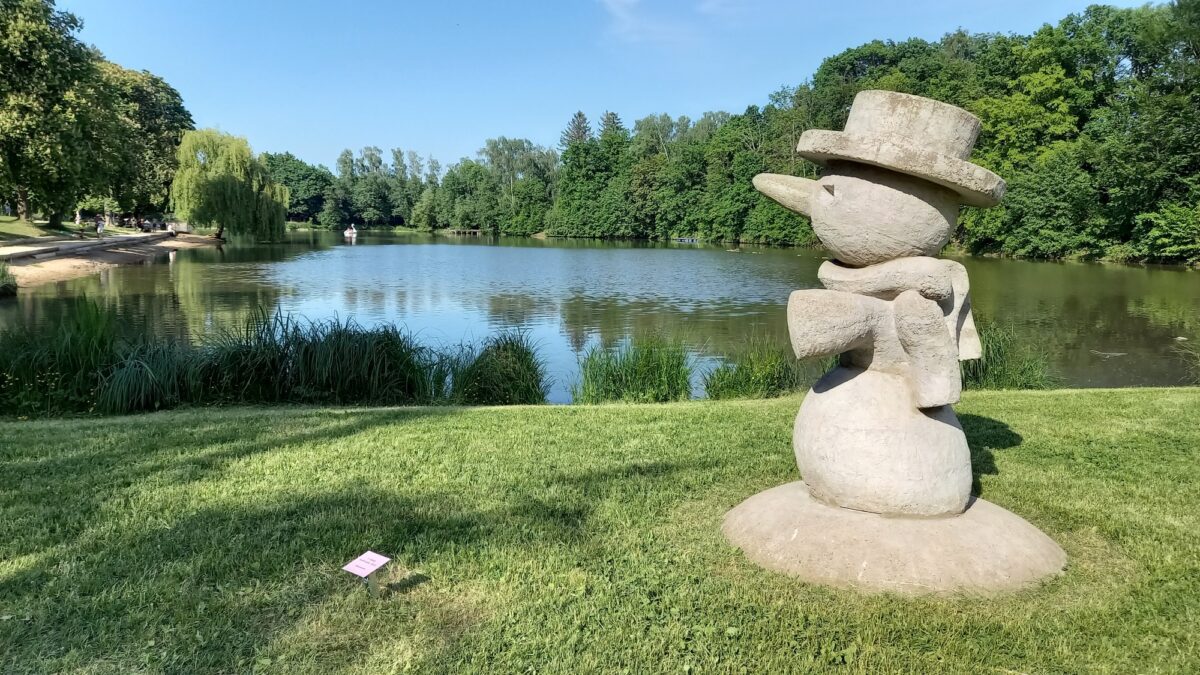
Říčany at the turn of the 19. and 20th century became a Prague resort, but it had one disadvantage compared to other recreational locations – the lack of bathing areas. Therefore, the town had the ancient pond Marvánek restored in 1934 and three years later opened a large modern swimming pool with a beach and sections for swimmers, non-swimmers and children. Amenities included cabins with a roof terrace, showers, a diving board, a slide, a number of entertainment facilities and a restaurant. In the summer seasons, festivals and swimming races were held here. In winter, Marvánek was used as an ice rink for ice skating and hockey. The swimming pool served its purpose for many decades until it fell into complete disrepair. Today, the Marvánek pond serves as a natural, untreated swimming pool.
Church of St. Wenceslas in Jažlovice
The village of Jažlovice, formerly called Žežlovice, lies 3.5 km southwest of Říčany. There used to be a fortress here, mentioned in 16. century. In the eastern part of the village stands the originally Romanesque church of St. Václav with a horseshoe-shaped apse and a slightly younger cylindrical tower. The original Romanesque rotunda (now the apse) was built in the 13th century. century, partly demolished and extended with a nave made of large blocks. The church was gradually Baroqueised and its nave was enlarged again in 1854. Inside the church it is worth seeing the recently discovered Gothic frescoes from the beginning of the 15th century. century. In front of the church there is an interesting partly dilapidated cemetery, not used for a long time. Research is currently underway that could yield further secrets about the church, which was one of the first in Bohemia.
Educational trail “Říčansko”
The nature trail introduces visitors to the town of Říčany with some of its sights and the nature in its immediate surroundings. The easy walk, less than 9 km long, is manageable even for less skilled hikers. The first station is in the centre of Říčany, near the old town hall on Masaryk Square. The trail initially passes through the town, then through the surrounding forests and finally returns in a curve back to Říčany to the Jureček swimming pool. The whole trail runs along well-passable urban, dirt and forest paths, suitable for children. The first three of its eighteen stops are devoted to history and culture, the last to culture and general environmental issues. All the other stops are thematically focused on nature and nature-related activities: trees, fishery, botany, mammals, mind